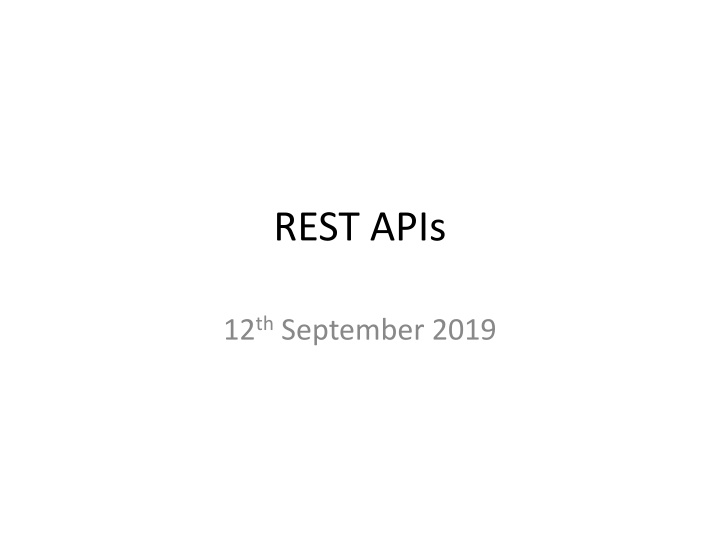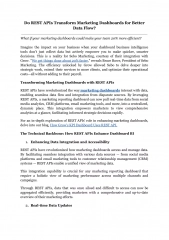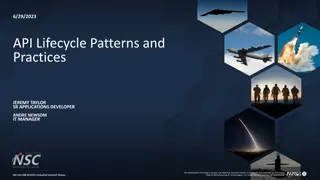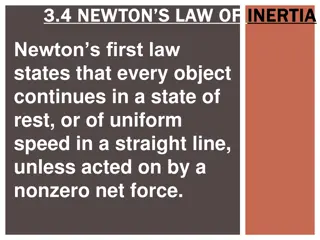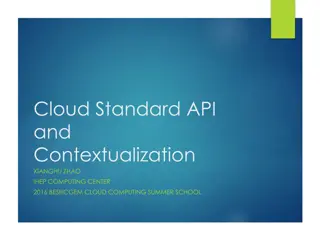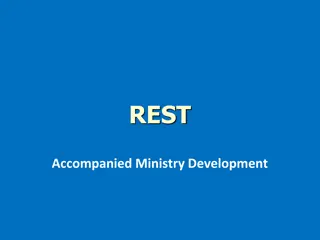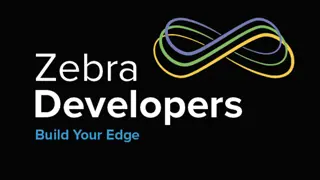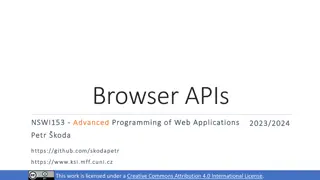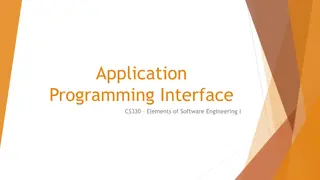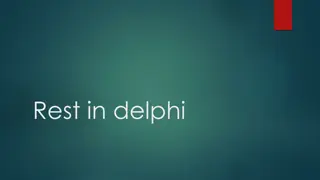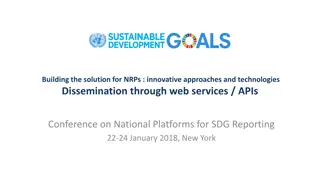REST APIs
Explore the world of RESTful APIs in this informative content. Learn about their significance, principles, and practical implementation. Dive into the fundamental concepts of REST architecture, HTTP methods, and best practices for designing and consuming APIs. Enhance your knowledge on RESTful web services to leverage their benefits in modern software development.
Download Presentation

Please find below an Image/Link to download the presentation.
The content on the website is provided AS IS for your information and personal use only. It may not be sold, licensed, or shared on other websites without obtaining consent from the author.If you encounter any issues during the download, it is possible that the publisher has removed the file from their server.
You are allowed to download the files provided on this website for personal or commercial use, subject to the condition that they are used lawfully. All files are the property of their respective owners.
The content on the website is provided AS IS for your information and personal use only. It may not be sold, licensed, or shared on other websites without obtaining consent from the author.
E N D
Presentation Transcript
REST APIs 12thSeptember 2019
Progress with your web app You know how to set up a database and access it via PHP Can construct any queries you want using PHP Can use PHP to retrieve information from the front end How exactly does this work? Today we see how to streamline data transfer from DB to front-end using APIs
How does an HTTP client talk to the server? Consider a simple form submission <html> </html> <body> <form action="registration.php" method="post"> Name: <input type="text" name="name"> Email: <input type="text" name="email"> <input type="submit"> </form> </body> How does PHP handle this?
PHP The registration.php file <html> </html> <body> </body> Welcome <?php echo $_POST["name"]; ?> ! Your email address is <?php echo $_POST["email"]; ?> What does the client see?
Hypertext Transfer Protocol (HTTP) A communications protocol Allows retrieving inter-linked text documents (hypertext) World Wide Web. HTTP Verbs GET /index.html HTTP/1.1 Host: www.pitt.edu HEAD GET POST PUT DELETE TRACE OPTIONS CONNECT Browser Web Server HTTP/1.1 200 OK Content-Type: text/html <html><head> 5
HTTP requests GET Used to send information to server Information sent is visible in URL 2048 character limit No binary data Information sent is accessible in $_GET associative array in PHP POST Used to send information to server Information sent is invisible No real limit, default limit is 8 MB, configurable in php.ini file Information sent is accessible in $_POST associative array in PHP Associative arrays are indexed by strings. In HTTP context, by field names
Representational State Transfer (REST) A style of software architecture for distributed hypermedia systems such as the World Wide Web. Introduced in the doctoral dissertation of Roy Fielding One of the principal authors of the HTTP specification. A collection of network architecture principles which outline how resources are defined and addressed 7
REST and HTTP The motivation for REST was to capture the characteristics of the Web which made the Web successful. URI Addressable resources HTTP Protocol Make a Request Receive Response Display Response Exploits the use of the HTTP protocol beyond HTTP POST and HTTP GET HTTP PUT, HTTP DELETE 9
REST - not a Standard REST is not a standard JSR 311: JAX-RS: The JavaTM API for RESTful Web Services But it uses several standards: HTTP URL XML/HTML/GIF/JPEG/etc (Resource Representations) text/xml, text/html, image/gif, image/jpeg, etc (Resource Types, MIME Types) 10
Main Concepts Nouns (Resources) unconstrained i.e., http://example.com/employees/12345 REST Verbs constrained i.e., GET Representations constrained i.e., XML 11
Resources The key abstraction of information in REST is a resource. A resource is a conceptual mapping to a set of entities Any information that can be named can be a resource: a document or image, a temporal service (e.g. "today's weather in Los Angeles"), a collection of other resources, a non-virtual object (e.g. a person), and so on Represented with a global identifier (URI in HTTP) http://www.boeing.com/aircraft/747 12
Naming Resources REST uses URI to identify resources http://localhost/books/ http://localhost/books/ISBN-0011 http://localhost/books/ISBN-0011/authors http://localhost/classes http://localhost/classes/cs2650 http://localhost/classes/cs2650/students As you traverse the path from more generic to more specific, you are navigating the data 13
Verbs Represent the actions to be performed on resources HTTP GET HTTP POST HTTP PUT HTTP DELETE 14
HTTP GET How clients ask for the information they seek. Issuing a GET request transfers the data from the server to the client in some representation GET http://localhost/books Retrieve all books GET http://localhost/books/ISBN-0011021 Retrieve book identified with ISBN-0011021 GET http://localhost/books/ISBN-0011021/authors Retrieve authors for book identified with ISBN-0011021 15
HTTP PUT, HTTP POST HTTP POST creates a resource HTTP PUT updates a resource POST http://localhost/books/ Content: {title, authors[], } Creates a new book with given properties PUT http://localhost/books/isbn-111 Content: {isbn, title, authors[], } Updates book identified by isbn-111 with submitted properties 16
HTTP DELETE Removes the resource identified by the URI DELETE http://localhost/books/ISBN-0011 Delete book identified by ISBN-0011 17
Representations How data is represented or returned to the client for presentation. Two main formats: JavaScript Object Notation (JSON) XML It is common to have multiple representations of the same data 18
Representations XML <COURSE> <ID>CS2650</ID> <NAME>Distributed Multimedia Software</NAME> </COURSE> JSON {course {id: CS2650} {name: Distributed Multimedia Sofware} } 19
Why is it called "Representational State Transfer"? http://www.boeing.com/aircraft/747 Resource Client Fuel requirements Maintenance schedule ... Boeing747.html The Client references a Webresource using a URL. A representation of the resource is returned (in this case as an HTML document). The representation (e.g., Boeing747.html) places the client application in a state. The result of the client traversing a hyperlink in Boeing747.html is another resource accessed. The new representation places the client application into yet another state. Thus, the client application changes (transfers) state with each resource representation --> Representation State Transfer! 20
Architecture Style Request (XML doc) HTTP GET URL 1 doGet() Response (XML doc) HTTP Response Web/Proxy Server doPost(id) HTTP POST REST Engine (locate resource and generate response) Request (XML doc) URL 1 HTTP Response Response (JSON doc) doDelete() HTTP DELETE PO URL 1 (XML doc) Response (TEXT doc) HTTP Response 21
Principles of RESTfulness Client-server architecture UI should be separate from data store Statelessness Server should not have to store any information about the client s context Each client request should be self-contained Cacheability Responses must be defined to be cacheable Layered system Client should not care if it is connected to the main server or an intermediary Code on demand Server should have the capacity to deliver executable code Uniform interface Resource identification in requests Resource manipulation through representations Self-descriptive messages Client should not need prior knowledge of app structure https://en.wikipedia.org/wiki/Representational_state_transfer#Architectural_constraints
Real Life Examples Google Maps Google AJAX Search API Yahoo Search API Amazon WebServices 23
References Representational State Transfer http://en.wikipedia.org/wiki/Representational_State_Trans fer Roy Fieldings Thesis http://www.ics.uci.edu/~fielding/pubs/dissertation/top.ht m 24
